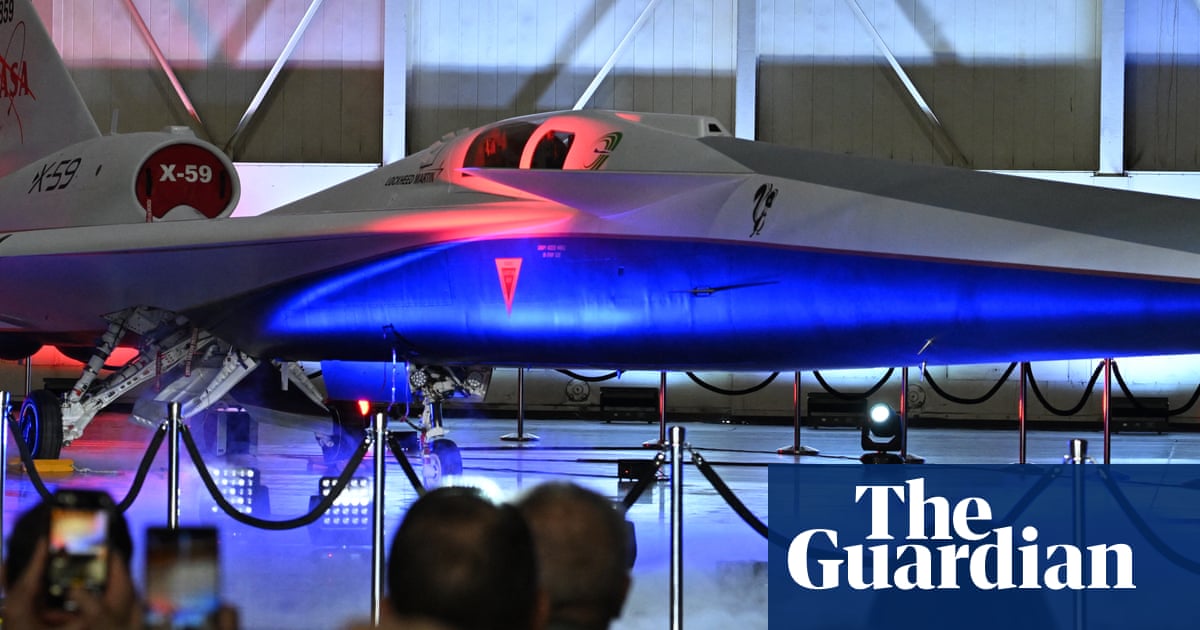In launch event on Friday, agency shared plans to test over US cities to see if it’s quiet enough by engaging ‘the people below’
Nasa has unveiled a one-of-a-kind quiet supersonic aircraft as part of the US space agency’s mission to make commercial supersonic flight possible.
In a joint ceremony with Lockheed Martin Skunk Works in Palmdale, California, on Friday, Nasa revealed the X-59, an experimental aircraft that is expected to fly at 1.4 times the speed of sound – or 925mph (1,488 km/h).
The aircraft, which stands at 99.7ft (30.4 metres) long and 29.5ft wide, has a thin, tapered nose that comprises nearly a third of the aircraft’s full length – a feature designed to disperse shock waves that would typically surround supersonic aircraft and result in sonic booms.



What is your plan for intercontinental travel? Increased ship travel, taking a week and burning massive amounts of crude fuel oil? Just cut off the Americas and Australia from Europe, Africa and Asia for non-commercial purposes? The supersonics have mostly been used for trans-atlantic and trans-pacific travel.
Less and more efficient airplanes. Supersonic aircraft will consume more fuel.
Let’s get weird with blimps
These kinds of comments only say it’s wrong; they never make a valid contribution to finding a solution.
The guy you’re replying to or the nonce suggesting we shelve all transportation technology and only use trains?
The nonce, of course.
Oh good, he has too many upvotes for me to assume but I figured.
It’s such a shame, you’d think these communities would be about how advancement is always good due to it unlocking new possibilities. For example, maybe this aircraft will open up doors in hypersonic flight that could be used to make more efficient SSTO model and get us less dependent on fossil fuels for chemical rockets via traditional means. Or allows materials science to make a leap forward that revolutionizes fusion.
To just say “why are we doing this?” Is an absolutely insane perspective for R&D and a fundamental misunderstanding of the way we develop technologies.
I think part of the issue is that the fine granularity of Lemmy (or the other place we don’t speak of) doesn’t lend easily to broader topics but instead seems to pull in “only THIS” or “only THAT” binary thinking. Only bikes or only trains or only trams doesn’t help when you need to cross continents.
sailing and solar power exists, and i’m pretty dang certain we could get an ocean liner to cross the atlantic in less than a week with modern tech. Also probably still less emissions than air travel considering how absurly much fuel that uses.
There is a reason the tall masted rigged ships disappeared for regular travel; most people don’t want to take a month to cross the ocean in close quarters. Cruise ships are the closest analog to a long haul jet, and are no better to twice as CO2 producing than the airline travel, and the fuel they burn is the lowest grade fuel oil with the worst additional pollution. If you are moving across the ocean, or even just traveling, most people won’t be able to pilot their own sailing yacht and take 15-30 days to do it.